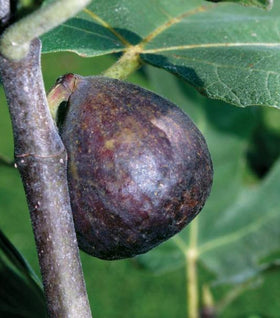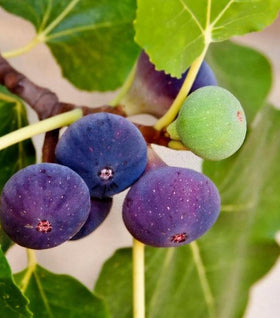Fig Trees for Sale Online
Fig trees are one of the easiest fruit trees to grow in the garden. They are self-pollinating meaning they don't require another fig tree for pollination. Even the smallest of gardens can enjoy fresh figs. Fig Trees will produce figs in 1 year, so the tree you buy today will produce figs in the same year!
Figs ripen in late summer into the fall. They are low maintenance, drought-tolerant, and more cold hardy than most people think. The only requirement is that they are planted in full sun and well-drained soil. In these conditons, fig trees can grow up to 20 feet if planted in the ground, but can survive in containers.
Fun Fact about Figs: The figs we eat are not fruits; technically figs are inverted flowers (Inside Out). Fig trees don’t flower like other fruit trees. Fig flowers bloom inside the pear-shaped pod, which matures into the small to the medium-sized fruit that we eat. Each flower produces a single, one-seeded, hard-shelled fruit called an achene, and that’s what gives figs the crunch we know. Since figs are made up of multiple achenes, when we eat them, we are actually eating numerous fruits at one time.
Growing Fig Trees in the Garden
Fig trees prefer a sunny spot in your yard. They can tolerate partial sun but need as much sun as they can get to produce the most fruit. A minimum of 7 to 8 hours of sun exposure is recommended for fig trees.
If your space is limited, fig trees can be planted in containers. If you decide to grow your figs in containers, they will need to be potted up every other year or so, so plan accordingly.
Planting a Fig Tree
After you've chosen the best spot for your Fig tree, there are a few easy to follow steps for planting your tree. Fig trees can be planted at most any time of the year as long as the soil can be worked.
Step 1: Water the tree thoroughly while it is in the pot. Water until you see the water running out of the bottom of the pot. If you are planting bare-root fig trees, it is recommended to allow the roots to sit in a bucket of water for 1 to 2 hours to allow the roots to rehydrate.
Step 2: Dig a hole twice as wide as the pot the tree is growing in. The depth of the hole should be as deep as the root ball, but not deeper. After the tree is planted, you should still be able to see the original nursery soil. Planting the tree too deep is the leading cause of poor growth and death of newly planted fig trees.
Step 3: If your existing soil is of poor quality, you should amend the soil with local compost or peat moss at a 50/50 rate. This is also the time to mix in an organic starter fertilizer such as Bio-tone by Espoma.
Step 4: Place the Fig tree in the prepared hole, being careful not to overly disturb the roots. It is ok to fluff the roots if the tree is rootbound lightly. This will cause the tree roots to begin to grow out and down rather than circle the root ball.
Step 5: Begin back-filling with the amended soil in 3 to 4-inch layers being careful to tamp the soil between layers. This will remove air pockets and voids created by larger chunks of soil. Be cautious not to damage the existing roots of the tree during this process.
Step 6: Use the leftover soil to create a 3 to 4-inch rim around the planting hole's edges. This will allow water to pool around the newly planted tree and slowly seep into the root zone. Proper watering is essential to the survival of the tree.
We also recommended to mulch the newly planted apple tree. This helps prevent the sun from drying out the soil and damage from mowing equipment such as string-trimmers.
Watering Fig Trees
Newly planted fig trees should be watered every 2 to 3 days for the first 4 weeks. After that, begin to cut back on the watering frequency but not the amount of water. When watering, be sure to soak the entire root system. Remember that the root system is usually 18 inches deep on a newly planted tree, and water should soak all the way through the bottom.
Two of the easiest ways to water newly planted fig trees is to lay the end of the hose at the base of the tree inside the rim and allow it to trickle at the base for 30 to 40 minutes or until you see the water begin to pool.
The second way and our favorite way is to use a Dewitt Dew Right Watering Donut. Install the bag at the base of the tree and fill it with water. Water is allowed to slowly drain from the bag providing the perfect amount of water to the root zone. Dewitt Dew Right Watering Donut are better suited for fig trees due to their lower branching.
Pruning of Fig Trees
Fig Trees rarely need to be pruned, if at all. Some growers who incorporate fig trees into the landscape prefer to "Prune Up" Fig Trees. To do this, prune off the lower branches so that the fig tree's interesting multi-stemmed habit can be seen.
Growing Figs in Northern Areas
Figs can be grown into zone 6 but a little extra care is needed in the winter. Once the leaves have fallen off of the tree in the late fall. In the early winter before the severely cold winter temperatures arrive. Wrap the branches of the fig tree with burlap in multiple layers if possible. Bundle the branches with string and coil the string tightly being careful not to snap the branches. This bundle can then be wrapped with plastic or tar cloth. Make sure the top of the bundle is sealed to avoid excess water from entering the "Bundle".
Harvesting Figs
Figs should be allowed to ripen fully on the tree before picking. The fruit will be a brown or purple color when fully ripe. Figs that are left on the tree too long will develop a sour taste, so figs need to be picked as they ripen.



